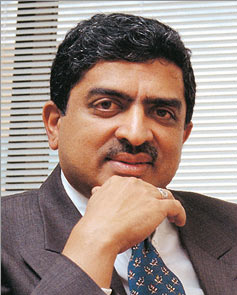 | « Back to article | Print this article |
 A task force led by Nandan Nilekani on Thursday suggested that 10 lakh business correspondents be appointed to ensure that social sector schemes' benefit reach the intended beneficiaries in about six lakh villages.
A task force led by Nandan Nilekani on Thursday suggested that 10 lakh business correspondents be appointed to ensure that social sector schemes' benefit reach the intended beneficiaries in about six lakh villages.
The 'Task Force on the Aadhaar-Enabled Unified Payment Infrastructure' made this recommendation so that these one million "mini ATMs" could be used to make payments to beneficiaries in 2.25 lakh gram panchayats containing six lakh villages besides serving the urban poor.
Banking correspondents are the persons who facilitate banking and financial services at places where full-fledged banking services are not available.
It further said that the government should bear the last mile transaction fee of 3.14 per cent subject to a cap of Rs 20 per payment.
These recommendations form a part of the report which was presented today to the Finance Minister Pranab Mukherjee by UIDAI-Chairman Nandan Nilekani in the presence of Agriculture Minister Sharad Pawar, Rural Development Minister Jairam Ramesh and Food Minister K V Thomas.
At present the rural banking infrastructure only consist of about 30,000 bank branches and 1,20,000 post offices in contrast to the 80,000 bank branches, 150,000 post offices, 88,000 ATMs, and five lakh point of sale machines in the entire country.
"We have recommended a network of 10 lakh micro ATMs around the country which are going to be small electronic devices in various villages," Nilekani told reporters after meeting Mukherjee.
"We have also recommended transaction fee but the govt will take a final decision. This is a platform... for any payment to anyone.. be it entailment payment, subsidy payment, procurement payment. We have been given direction to work on this and roll it out in next one year," he added.
Nilekani also pointed out that the network of one million business correspondents will help making huge government payments of benefits and subsidies of about Rs 3 lakh crore through electronic mode every year.
"The government makes a large number of payment of about Rs three lakh for NREGA, fertilizer, cooking gas, kerosene and food. The (task force's) proposal is, how to make this much more in electronic manner and use Aadhar as basis of crediting money in bank accounts," he said.
Nilekani said, "We have been given direction to work on this and roll it out in next one year." The report said that this fee (of 3.14 per cent) is benchmarked against other offerings with similar characteristics.
At present, India Post charges 5 per cent fee for money orders while mobile operators started with 16 per cent agent commission for top-up ten years back, which has now stabilised at 3.5 per cent average.
According to report, the task force's recommendations are in sync with the Reserve Bank of India's 'Payment Systems in India-Vision 2009-12' under which it has envisaged cash-less economy.
"The Aadhaar number due to its uniqueness property, serves as a natural financial address for sending payments to accounts of beneficiaries at banks and post offices through the Aadhaar Payment Bridge (APB)", the report said adding that it enables authentication of the beneficiary in real-time in a trusted manner during last-mile payments using Micro-ATMs.